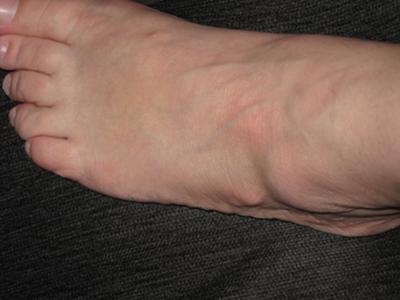Overview
 A bunion is a bony protrusion on the side of the big toe or in some less common cases on the outside of the small toe. The protrusion at the joint of the base of the toe can become irritated, swollen and painful. As the protrusion becomes larger the toe bends toward the second toe causing further sources of irritation. There appears to be multiple causes of a bunion. Genetically the foot may be shaped such that normal activity puts excessive pressure on the big toe eventually causing a bunion. Some suggest footwear that does not fit properly may also put excessive pressure and cause a bunion. The protrusion may be excessive bone structure or a fluid sac called the bursa that becomes inflamed. In any case the deformity of the toe makes it difficult to find proper fitting footwear, is not a pleasant sight, and can be very painful.
A bunion is a bony protrusion on the side of the big toe or in some less common cases on the outside of the small toe. The protrusion at the joint of the base of the toe can become irritated, swollen and painful. As the protrusion becomes larger the toe bends toward the second toe causing further sources of irritation. There appears to be multiple causes of a bunion. Genetically the foot may be shaped such that normal activity puts excessive pressure on the big toe eventually causing a bunion. Some suggest footwear that does not fit properly may also put excessive pressure and cause a bunion. The protrusion may be excessive bone structure or a fluid sac called the bursa that becomes inflamed. In any case the deformity of the toe makes it difficult to find proper fitting footwear, is not a pleasant sight, and can be very painful.
Causes
Bunions may be hereditary, as they often run in families. This suggests that people may inherit a faulty foot shape. In addition, footwear that does not fit properly may cause bunions. Bunions are made worse by tight, poorly-fitting, or too-small shoes. Bunions may also happen due to inflammatory conditions such as arthritis. Anyone can get bunions, but they are more common in women. People with flat feet are also more likely to get bunions due to the changes in the foot caused by bunions. There is also a condition called adolescent bunion, which tends to occur in 10-to-15-year old girls.
Symptoms
If you have a bunion, you may have pain or stiffness of your big toe joint, swelling of your big toe joint, difficulty walking, difficulty finding shoes that fit. These symptoms may be caused by conditions other than bunions, but if you have any of these symptoms, see your doctor.
Diagnosis
Looking at the problem area on the foot is the best way to discover a bunion. If it has the shape characteristic of a bunion, this is the first hint of a problem. The doctor may also look at the shape of your leg, ankle, and foot while you are standing, and check the range of motion of your toe and joints by asking you to move your toes in different directions A closer examination with weight-bearing X-rays helps your doctor examine the actual bone structure at the joint and see how severe the problem is. A doctor may ask about the types of shoes you wear, sports or activities (e.g., ballet) you participate in, and whether or not you have had a recent injury. This information will help determine your treatment.
Non Surgical Treatment
Technically, you can only ?fix a bunion? with surgery, but many patients don't need it to get symptom relief. In its early stages, the progression of the bunion deformity can often be dramatically slowed. Removing pressure from the bunion area and balancing the tendon and ligament alignment are the primary goals of mild bunion treatment. For example, it is important to wear shoes that have sufficient room in the toe area to accommodate the bunion - that means softer leather shoes to mold to the deformity and platform type heels for better foot and arch support. Your doctor may also advise the use of pads to protect the bunion from shoe pressure. Customized shoe inserts, called orthotics are made exclusively for your foot and are often used to correct the alignment of the arch and big toe joint. In some cases, physicians also use anti-inflammatory creams around the bunion. 
Surgical Treatment
If non-surgical treatments have failed to relieve your bunion pain, or when the pain is interfering with your daily activities, contact the Dallas bunion surgery specialists at North Texas Foot & Ankle to discuss surgical options. There are a several ways to perform bunion surgery. The best procedure for one person is not necessarily the best for another. Some procedures allow you to walk much sooner, reducing the need for crutches. Depending on your foot type, the procedure can have a greater risk for return of the bunion deformity. Other procedures may require you to be on crutches for a few weeks - but could offer a better result in the long-term. Learn more about the different types of bunion surgery.
۱۳:۳۴
- ۰ بازديد
- ۰ نظر